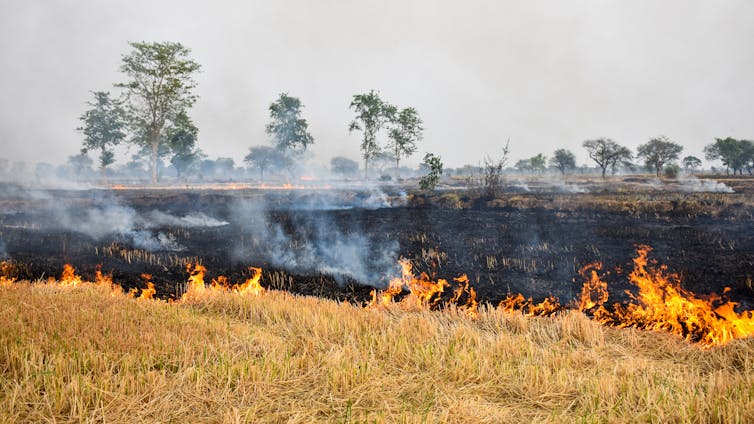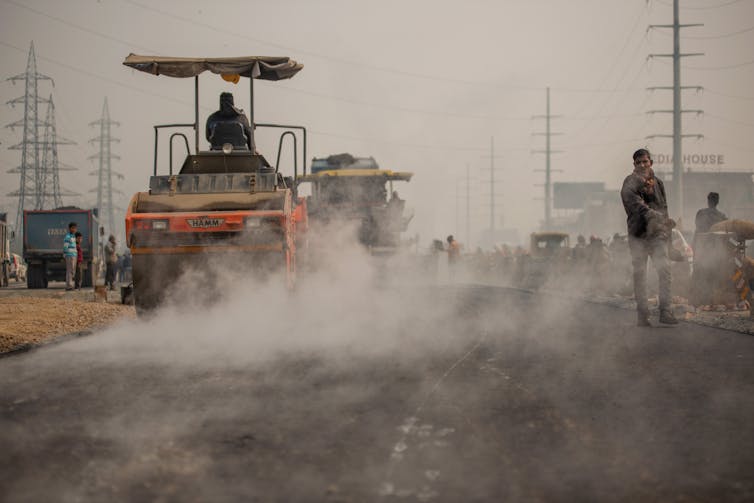Komali Kantamaneni, University of Central Lancashire and Sigamani Panneer, Jawaharlal Nehru University
Delhi’s air pollution is so bad that it’s sometimes hard to discern anything more than a few metres in front of you. And it is affecting people’s health. Breathing is uncomfortable, and one of us (Komali) developed rashes and red eyes on a recent trip to the city.
Our experiences are not unusual. Delhi – officially the National Capital Territory of Delhi – is the world’s second most populated urban area, and is among its most polluted. Air pollution recently went 26 times over the healthy limit prescribed by the World Health Organization.
The air quality index, or AQI, is a measure of how polluted the air is on a scale of 0 (clean) to 500 (maximum pollution). On November 19, Delhi’s average was 485. Many of its air pollution sensors maxed out at 500, so the true figure would be even higher.
Things peak every winter when many people suffer from respiratory problems and hospital visits increase. An extraordinary 11.5% of all deaths in the city can be attributed to air pollution, a loss of around 12,000 lives every year.
A human-made calamity
This is a human-made calamity with many causes. Some factors are common to many large and fast-growing cities, especially in emerging economies. Delhi has many coal power plants, for instance, and its streets are choked with heavy traffic. Decades of dust, often from the construction industry, have accumulated in and around the city. Waste is often simply burned.

But some factors are more specific and it is these that push Delhi from “regular pollution” into catastrophe. Every year, farmers across northern India especially the breadbasket states of Punjab and Haryana burn off unwanted straw left behind in fields, sending huge clouds of smoke downwind towards Delhi. Fireworks during Diwali (held on October 31 this year) also cause a small but noticeable increase in air pollution.
All this is exacerbated when winter begins and colder and more polluted air becomes trapped over the city by a layer of warmer air above it – a process known as temperature inversion.
A conscious effort
The risk of pollution is increasing. Central and state authorities blame each other and there is a lack of political will to address the problem. Individual people seem unwilling to take responsibility and stop polluting.
A conscious effort is needed. Fortunately, certain policies could make a difference. Materials should be covered at construction and demolition sites, for instance, to stop so much dust from being blown into the air. This may require Delhi to strengthen its legal enforcement system.

The city should plant more pavement trees and create new parks. Trees are good at combating air pollution. Waste burning should be restricted. Eventually, coal power will need to be replaced by wind and especially solar. When pollution is at its worst, the city can impose strict restrictions on large diesel-powered freight vehicles transporting non-essential items.
Farmers, for their part, must stop burning plant material left behind (known as stubble) after food is harvested. This is easier said than done. The areas upwind of Delhi tend to have two growing seasons, and many farmers burn off their rice stubble in November before planting wheat in the same field. The system has persisted for a long time and is effectively locked in, with most powerful actors not having enough incentive to change things.
There are some alternatives. Farmers could be encouraged to diversify their crops, perhaps through conditions attached to loans. Some of that stubble could instead be used as cattle feed, in compost, as a roof material, or burned in bioenergy plants to produce electricity.
Evidence-based strategies and best practices are crucial. The goal must be to reduce the air quality index to the “good” category of 0–50 and ultimately to eliminate toxic air in Delhi and the surrounding region.
Komali Kantamaneni, Co-Director, United Nations- SPIDER- UK Regional Support Office, Senior Research Fellow, School of Engineering, Preston, UK, University of Central Lancashire and Sigamani Panneer, Professor, Jawaharlal Nehru University
This article is republished from The Conversation under a Creative Commons license. Read the original article.











